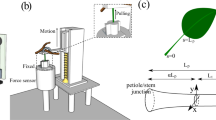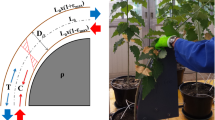Summary
Computer simulations were used to assess the influence of palmate leaf morphology, decussate phyllotaxy, and the elastic moduli of petioles on the capacity of turgid and wilted twigs ofAesculus hippocastanum to intercept direct solar radiation. Leaf size, morphology, orientation, and the Young's and shear moduli (E and G) of petioles were measured and related to leaf position on 8 twigs whose cut ends were placed in water (“turgid” twigs) and 8 twigs dried for 8 h at room temperature (“wilted” twigs). Petioles mechanically behaved as elastic cantilevered beams; the loads required to shear petioles at their base from twigs were correlated with the cross-sectional areas of phyllopodia but not with petiole length or tissue volume. Empirically determined morphometric and biomechanical data were used to construct “average” turgid and wilted twigs. The diurnal capacity to intercept direct sunlight for each was simulated for vertically oriented twigs for 15 h of daylight, 40° N latitude. The daily integrated irradiance (DII) of the wilted twig was roughly 3% less than that of the otherwise comparable twig bearing turgid leaves. Simulations indicated that the orientation of turgid leaves did not maximize DII. More decumbent (wilted) petioles increased DII by as much as 4%. Reduction in the girth, E, or G of petioles, or an increase in petiole length or the surface area of laminae (with attending increase in laminae weight), increased petiolar deflections and DII. Thus, the mechanical design of petioles ofA. hippocastanum was found not to be “economical” in terms of investing biomass for maximum light interception.
Similar content being viewed by others
References
Bierhorst DW (1971) Morphology of vascular plants. Macmillan Co., NY
Blevins RD (1984) Formulas for natural frequency and mode shape. P. E. Krieger Publishing Co., Malabar FL
Ehleringer JR (1980) Leaf morphology and reflectance in relation to water and temperature stress. In: Turner N, Kramer P (eds) Adaptations of plants to water and high temperature stress, Wiley-Interscience, New York, pp 295–308
Ehleringer JR, Werk KS (1986) Modifications of solar-radiation absorption patterns and implications for carbon gain at the leaf level. In: Givnish TJ (ed), On the economy of plant form and function, Cambridge University Press, Cambridge, pp 57–52
Gifford EM, Foster AS (1989) Morphology of vascular plants. W. F. Freeman Pub. Co., NY
Givnish TJ (ed) (1986) On the economy of plant form and function. Cambridge University Press, Cambridge
Horn HS (1971) The adaptive geometry of trees, Princeton University Press, Princeton NJ
Huang R-S, Smith WK, Yost RS (1985) Influence of vesicular-arbuscular mycorrhiza on growth, water relations, and leaf orientation inLeucaena leucocephala (Lam.) de Wit. New Phytol 99: 229–243
Mooney HA (1972) Carbon balance of plants. Ann Rev Ecol Syst 3: 315–346
Niklas KJ (1988) The role of phyllotactic pattern as a “developmental constraint” on the interception of light by leaf surfaces. Evolution 42: 1–16
Niklas KJ (1990a) Biomechanical responses ofChamaedorea andSpathiphyllum petioles to tissue dehydration. Ann Bot 67: 67–76
Niklas KJ (1990b) Effects of tissue volume and location on the mechanical consequences of dehydration of petioles. Am J Bot 78: 361–369
Niklas KJ (1991a) Flexural stiffness allometries of angiosperm and fern petioles and rachises: evidence for biomechanical convergence. Evolution 45: 734–750
Niklas KJ (1991b) The elastic moduli and mechanics ofPopulus tremuloides (Salicaceae) petioles in bending and torsion. Am J Bot 78: 989–996
Niklas KJ, Boyd SP (1987) Computer program for the threedimensional reconstructions and numerical analyses of plant organs from serial sections. Am J Bot 74: 1595–1599
Niklas KJ, Moon FC (1988) Flexural stiffness and modulus of elasticity of flower-stalks fromAllium sativum as measured by multiple resonance frequency spectra. Am J Bot 75: 1517–1525
Nobel PS (1950) Interception of photosynthetically active radiation by cacti of different morphology. Oecologia 45: 160–166
Nobel PS (1983) Biophysical plant physiology and ecology. W. H. Freeman, San Francisco
Nobel PS (1986) Form and orientation in relation to PAR interception by cacti and agave. In: Givnish TJ (ed), On the economy of plant form and function, Cambridge University Press, Cambridge, pp 83–103
Parkhurst D, Loucks O (1972) Optimal leaf size in relation to environment. J Ecol 650: 505–537
Shive Jr. JB, Brown KW (1978) Quaking and gas exchange in leaves of cottonwood (Populus deltoides, Marsh.). Plant Physiol 61: 331–333
Timoshenko S (1976) Strength of materials, Part 1. R. E. Krieger Pub. Co., Huntington; NY
Vogel S (1970) Convective cooling at low airspeeds and the shapes of broad leaves. J Exp Bot 21: 91–101
Author information
Authors and Affiliations
Rights and permissions
About this article
Cite this article
Niklas, K.J. Petiole mechanics, light interception by Lamina, and “Economy in Design”. Oecologia 90, 518–526 (1992). https://doi.org/10.1007/BF01875445
Received:
Accepted:
Issue Date:
DOI: https://doi.org/10.1007/BF01875445




